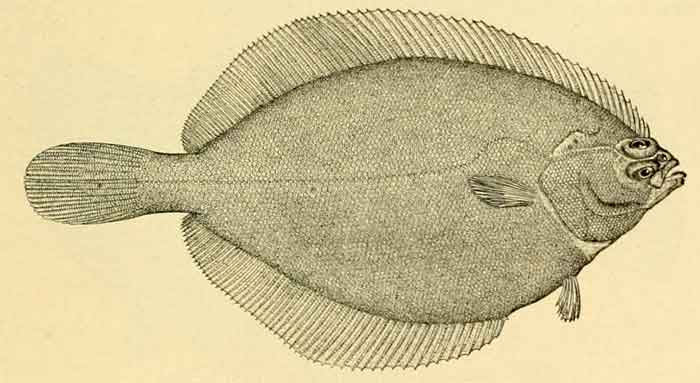
Superregnum: Eukaryota
Cladus: Unikonta
Cladus: Opisthokonta
Cladus: Holozoa
Regnum: Animalia
Subregnum: Eumetazoa
Cladus: Bilateria
Cladus: Nephrozoa
Superphylum: Deuterostomia
Phylum: Chordata
Subphylum: Vertebrata
Infraphylum: Gnathostomata
Megaclassis: Osteichthyes
Superclassis/Classis: Actinopterygii
Classis/Subclassis: Actinopteri
Subclassis/Infraclassis: Neopterygii
Infraclassis: Teleostei
Megacohors: Osteoglossocephalai
Supercohors: Clupeocephala
Cohors: Euteleosteomorpha
Subcohors: Neoteleostei
Infracohors: Eurypterygia
Sectio: Ctenosquamata
Subsectio: Acanthomorphata
Divisio/Superordo: Acanthopterygii
Ordo: Pleuronectiformes
Subordo: Pleuronectoidei
Familia: Pleuronectidae
Genera: Parophrys
Species
Parophrys vetulus Girard, 1854
English sole (Parophrys vetulus) is a species of flatfish in the family Pleuronectidae. It is a demersal fish that lives on sandy and muddy bottoms in estuaries and near shore areas, at depths of up to 550 metres (1,800 ft). It reaches up to 57 centimetres (22 in) in length, and can weigh up to 1.5 kilograms (3.3 lb). Its native habitat is the eastern Pacific, stretching from the coast of Baja California in the south to the Bering Sea in the north.[2][3]
English sole is an important commercial fish, primarily caught off Washington, Oregon and California. Though biomass is increasing, catches have been declining since the 1960s and are currently almost at an all-time low.[4]
English sole is known in Spanish as platija limón, or lemon sole, a name by which it is also known in English,[4][5] though the true lemon sole is a separate species, Microstomus kitt.
Etymology
The genus name is derived from the Greek para, meaning "near", ophrys, meaning "eyebrow", and the species name vetulus is a word meaning "old man".[6]
Description
The English sole is a right-eyed flatfish with a compressed, diamond-shaped body and a small head with a pointed snout and small, asymmetric mouth. The upper surface is covered in rough scales and is usually uniformly brown, but occasionally speckled; the lower surface is smooth, and white to pale yellow in colour. The dorsal and ventral fin edges are dark. The lateral line is mostly straight, but curves slightly around the pectoral fin.[7]
Diet
The diet of the English sole consists of zoobenthos organisms, primarily marine worms, molluscs, crustaceans and echinoderms. English sole feed by day, using both sight and smell, and often dig for food.[2][3][4]
Commercial fishing
The English sole is an important commercial fish, and has been fished in the Eastern Pacific, almost exclusively by trawler, since 1876. Two fisheries exist: one on the West Coast of the United States, off Washington, Oregon and California, and one in the Bering Sea off Alaska. The majority of English sole landed is from the West Coast fishery.[3][4]
Although biomass is increasing, catches have been steadily decreasing since the 1960s — though catches peaked in the southern area in 1929 with 3,976 tonnes (3,913 long tons; 4,383 short tons) landed, and in the north in 1949 at 4,008 tonnes (3,945 long tons; 4,418 short tons).[3] This decline is estimated to be due to a combination of market factors and management restrictions placed on fishing trawlers in order to protect other bottom-dwelling species.[4] However, the level of exploitation of this species has been low since 1997 within the Bering Sea and Aleutian Islands region, while it has been low for approximately 30 years on the West Coast of the United States, and most take occurs as bycatch.[1]
References
Bryan, M.; Spies, I.; Stevenson, D.; Munroe, T.A. (2021). "Parophrys vetulus". IUCN Red List of Threatened Species. 2021: e.T158632774A158638071. doi:10.2305/IUCN.UK.2021-3.RLTS.T158632774A158638071.en. Retrieved 12 August 2024.
Froese, Rainer; Pauly, Daniel, eds. (2018). "Parophrys vetulus month-February". FishBase.
Stewart, Ian J (25 May 2005). "Study of the US English sole resource 2005" (PDF). US National Marine Fisheries Service. Archived from the original (PDF) on January 9, 2009. Retrieved 2009-05-11.
"English Sole (Parophrys vetulus)". FishWatch. US National Marine Fisheries Service. Archived from the original on 26 December 2007. Retrieved 2009-05-11.
"Parophrys vetulus Girard, 1854". World Register of Marine Species. Retrieved 2009-05-11.
"ENGLISH SOLE". Pacific States Marine Fisheries Commission. 16 December 1996. Archived from the original on 1 September 2007. Retrieved 2009-05-11.
"English sole". Alaska Sea Grant Marine Advisory Bulletin No. 47. Oregon Department of Fish and Wildlife. Archived from the original on 7 August 2007. Retrieved 2009-05-11.
Retrieved from "http://en.wikipedia.org/"
All text is available under the terms of the GNU Free Documentation License

